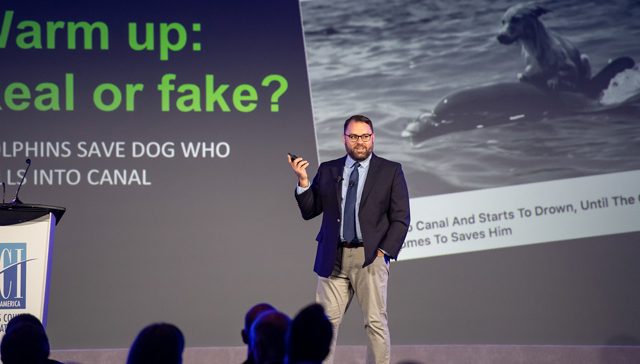General Session 2: ‘The Truth of the Matter Is... It’s Complicated’
![]() Print this Article | Send to Colleague
Print this Article | Send to Colleague

“The information space today is so complicated,” said Aaron Sharockman, Executive Director, Politifact, when leading off his keynote on Tuesday at General Session 2. “Everyone who has a phone can act like a journalist.” So the challenge becomes figuring out which news is legitimate. In an era of fake news, we are continually challenged as we separate fact from fiction, said moderator Sam Samaddar, Director, Kelowna International Airport.
Sharockman illustrated the difficulty of completing this task with a few rounds of “Real or Fake?” that were funny – but also scary. The man who supposedly took a solo flight on Delta. A dog who was rescued in a canal by a dolphin. A principal who banned candy canes. All were “real” stories, at least partially. What made them complicated was that parts of the story were real, and parts were not. It was the videos that added to the credibility, though, as they were the ones that were most believable. “This is something that keeps me up at night,” said Sharockman. “We believe things we see with our eyes. That is a big problem.” Case in point: The video featured with the dolphin-rescued dog was actually from a movie. It had nothing to do with the dog rescue.
So, how can you decide which posts are legitimate? With the “deep fakes,” Sharockman said to look for inconsistencies around the mouth, weirdness around the eyes or neck and problems with the audio. The “cheap fakes,” the ones that use manipulated or distorted video to reach misleading conclusions, can be tougher to spot. So, a good rule of thumb is to be skeptical of everything we see, in news feeds, particularly.
You can also fight back against misleading information. While there is no silver bullet, the answer is simple: “We need to get people to use their brains.”
Sharockman suggested using Wikipedia as a good place to go to source information. Also, you can do a reverse Google image search, “a powerful tool,” or something similar for YouTube videos using Amnesty International Youtube Dataviewer or InVid. There is also the practice of lateral reading, which is “super critical” and we don’t do enough of it, said Sharockman. It is where you search for information about the source, not the story. Most importantly, think critically when assessing a video.
When it comes to misinformation and disinformation, “This is a public health crisis. We all have to come together," said Sharockman. "We are fighting a war that we cannot win by ourselves." However, there is hope. "We can create a better information ecosystem.”
